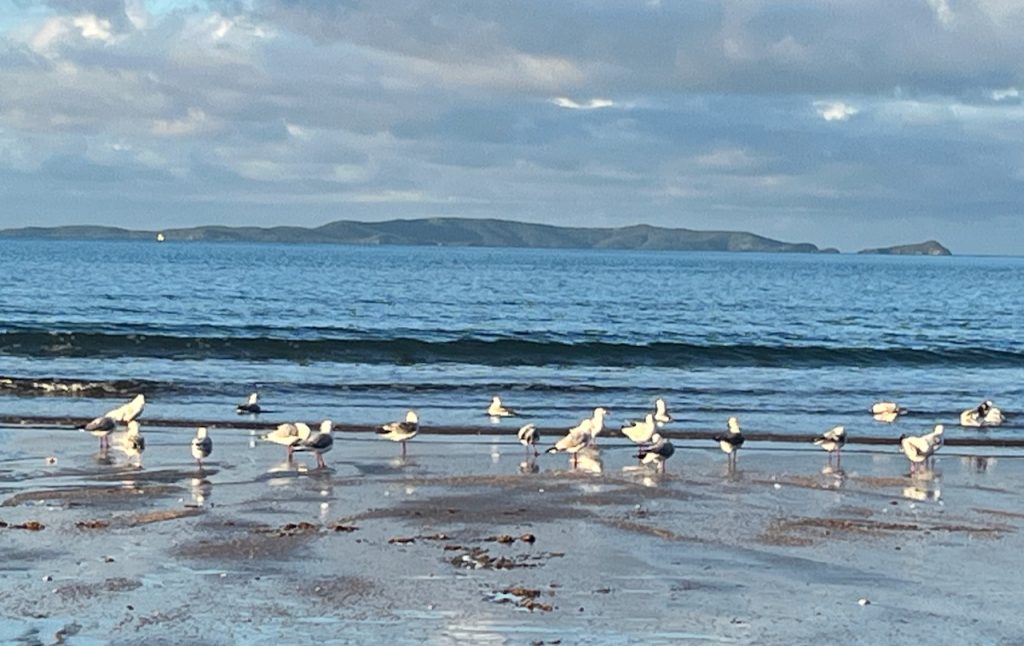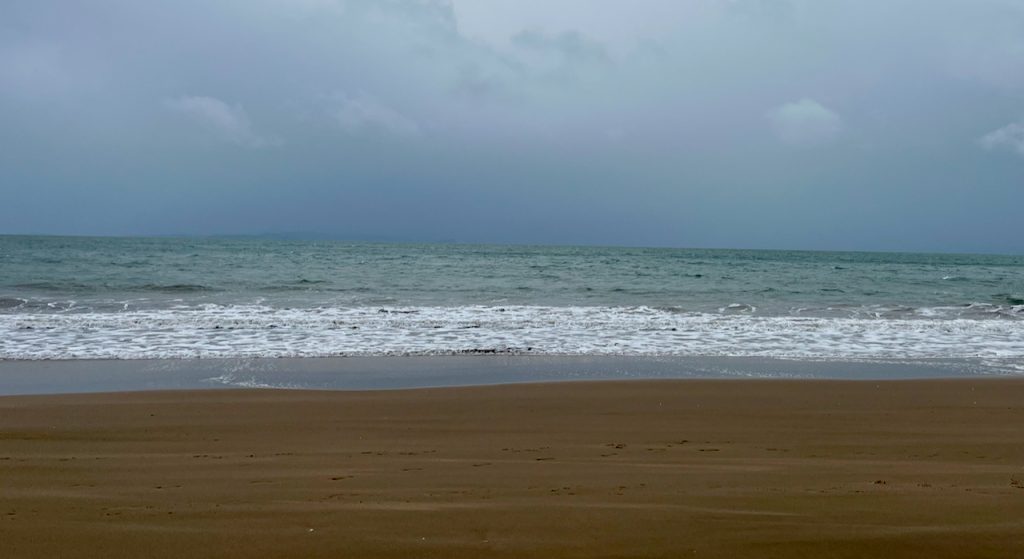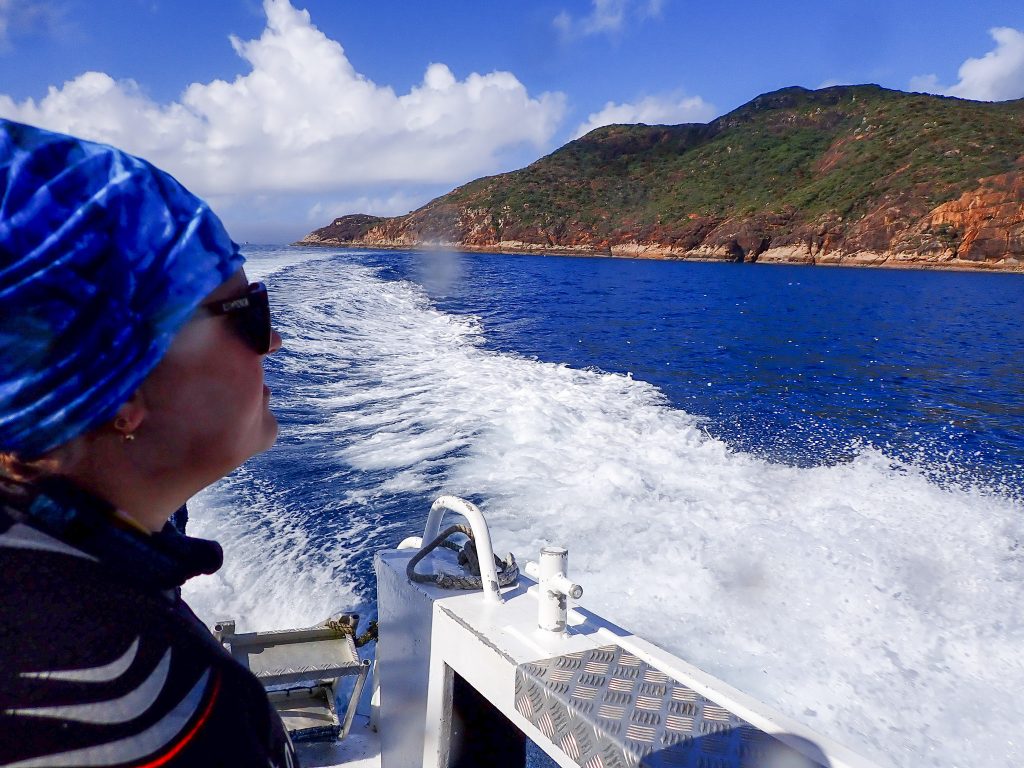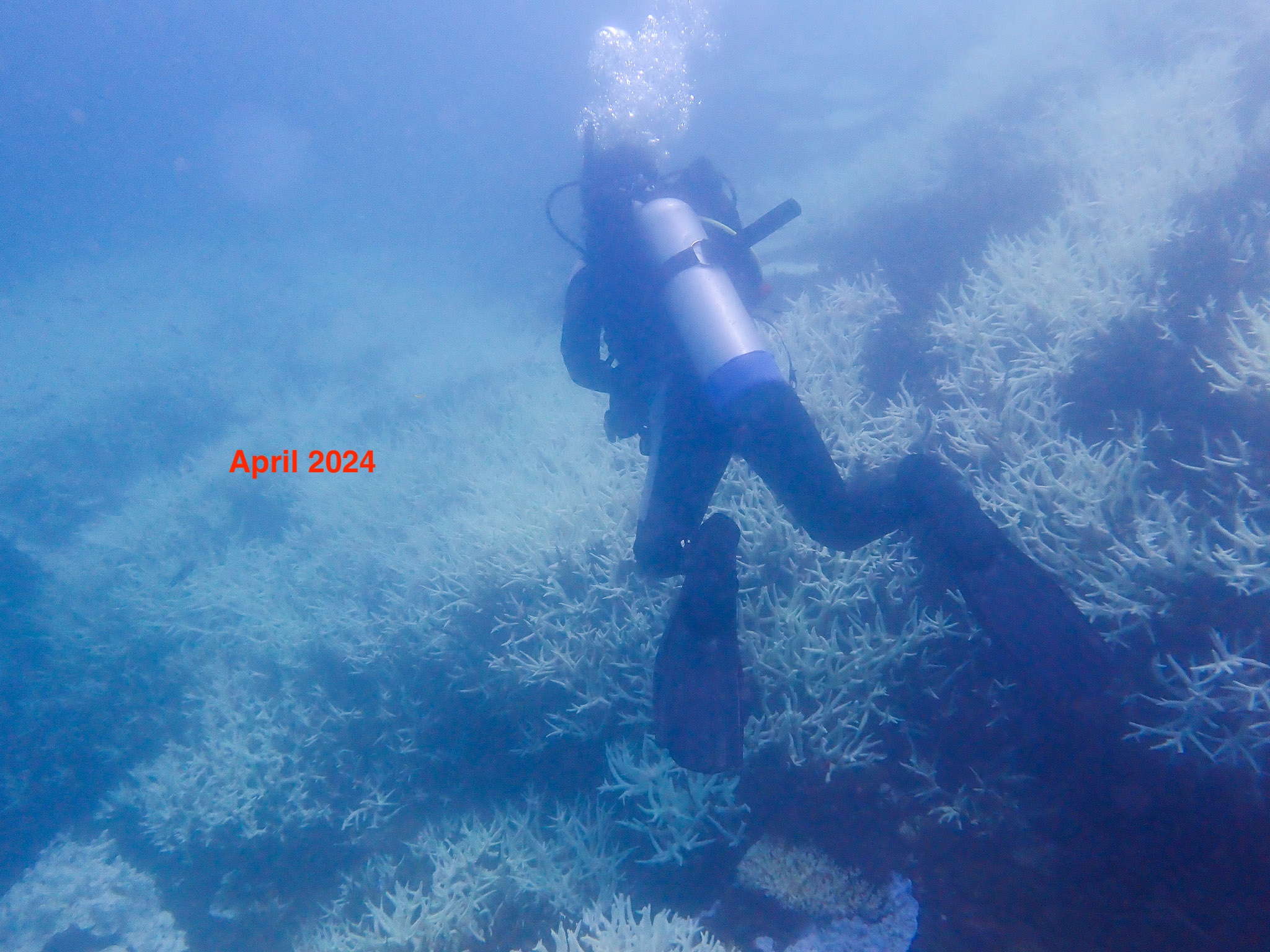Great Keppel Island is just across the bay from Lammermoor Beach. Tuesday afternoon I could see the island so clearly, and I took a short clip of some seagulls at the beach with my iPhone. Wednesday morning visibility was terrible. It was a fog – the island had disappeared, from sight. To understand fog, and what causes it, however temporary the phenomenon may be, we first need to acknowledge it. Which is more than most of my colleagues are doing when it comes to the changes in coral cover at the Great Barrier Reef this last year.


I couldn’t see across to Great Keppel Island on Wednesday morning. Not a reason to panic, but worth noting. If we are to understand how the seasons, tropical cyclones, and even the 18.6 year lunar declination cycle – how all of these natural phenomena can impact coral cover at the Great Barrier Reef, we first need to note the dramatic changes at individual coral reefs this year.
For sure there has been a very dramatic reduction in coral cover this last year at many reefs including my local reefs that are part of the southern Great Barrier Reef, and also at my favourite reef that is part of the central Great Barrier Reef, and many northern reefs were impacted by Tropical Cyclone Jasper – as was one of my favourite cities, Cairns where my dear mother lives.
Many Great Barrier Reef corals have been significantly impacted this last eight months, from cyclones and bleaching. It is disingenuous to suggest otherwise yet that is what so many of my colleagues are doing.
We have a situation were many opinion leaders on the right, who are usually so sceptical of official statistics are promoting them, including the ‘record high’ coral cover as reported by Graham Lloyd in a nonsense article in The Australian newspaper last weekend, spruiked by Peter Ridd and reposted by Joanne Nova and Anthony Watts. Such a shame. So many lies. And it does matter.
As I have been explaining to Peter Ridd the ‘record high coral cover’ this year might be a consequence of so much coral ‘dumped’ at the ‘perimeter’ of these reefs.
That might sound ridiculous, but then again so are the two candidates currently vying for leadership of the free world. This might seem unrelated, but only if you are unaware that little has changed in one thousand years, we are still ruled over by a greedy elite whichever side of politics.* And the Great Barrier Reef is not something those in power care about for its intrinsic beauty. Rather it is one of the most heavily politicised Climate Change™ subjects in Australia. Now I am quoting from the introduction to an interview I did recently with ‘Lies are Unbekoming’, at Substack also published last weekend, CLICK HERE.
It is perhaps the case that the Australian Institute of Marine Science (AIMS) in-water surveys show an increase in total coral cover because these are perimeter surveys and because at places like John Brewer Reef so much coral has fallen to the perimeter.
At John Brewer Reef much of the top of the reef, the reef crest, was swept clean of coral by Tropical Cyclone Kirrily when it struck on 25th January. It all happened that Thursday afternoon, over a period of some two hours.
I visited John Brewer Reef soon after and observed that some of the corals at the inside edge of this reef crest had been picked-up, flipped-over and dropped down over the edge – to the reef perimeter.
I wrote a blog post about this, entitled ‘Cyclone Kirrily Smashed my Favourite Coral Reef’, and in it I show parts of the reef crest scoured clean and so many large corals strewn over the edge, about the sandy sea floor – around the perimeter.
Indeed, that entire wall of coral that featured in the short film I made last year with Stuart Ireland starring Rowan Dean about the ‘Café Latte Coral’– that entire wall of coral with that famous coral from The Guardian newspaper: it collapsed, it broke off from the reef crest proper and is now strewn about the reef perimeter as a consequence of TC Kirrily.
As mad as this may sound, there is now opportunity for this famous coral to be part of the AIMS survey and it presumably was included in June, because the coral has been lost from the reef proper and is now at the perimeter of this coral reef, and AIMS are reporting an increase in coral cover at John Brewer Reef while denying the cyclone. I’ve written in detail about this just recently, CLICK HERE.
And as I explain in a rather long (5,000 words) interview, published at Substack last weekend:
Peter Ridd has gone to some effort over the last two years to promote these AIMS in-water coral cover surveys, to claim they show record high coral cover at the Great Barrier Reef. This may be what they show. But science is a method, it is not the truth. The truth exists independently of what might be reported.
In all the promotions, it is never acknowledged that these AIMS coral cover surveys are only of the reef perimeter, these surveys do not include the habitat with arguably the most coral cover that is the reef crest. The reef crest is not surveyed because this habitat can be difficult to survey at low tide in water.
Of course, just because something is difficult, that is not a reason for not doing it. Rather it would suggest AIMS, and its scientists, are more concerned with convenience than the truth.
I’ve explained to Rowan Dean, Peter Ridd and others, who have not got into the water at the Great Barrier Reef since last year, since 2023, that that whole wall of coral, including the famous coral that first featured on the front page of The Guardian – it has collapsed. I have explained to both, and to Graham Llloyd, that the Great Barrier Reef is not doing so well this year.
Of course, there are patches that are still magnificent – and terrific tourism operators who know their local reefs, including Keppel Dive and Adrenalin Dive know where to find them. Despite the tremendous loss of coral, I have so enjoyed scuba diving this year. As I explain in my answer to the very last question published at Substack just last weekend:
I was recently over at Great Keppel Island, the reef flat that we were diving was to my eye ‘ordinary’ and clearly suffering from the recent bleaching, but the American I was diving with, my buddy for that dive was an airline pilot from Colorado and he was in awe of this reef: the colourful fish and colourful corals. It was the first time he had dived at the Great Barrier Reef.
When I explained, after the dive, that this reef was suffering from the recent bleaching, he explained to me that it was the best dive he had ever done. He explained that ‘the best’ he ever gets to see on scuba back home in a nearby freshwater lake is a bit of moss growing on a wreck, a plane sunk into that same lake.
It is the case that not all environments are equally inspiring and rejuvenating.
For sure the Great Barrier Reef will recover. But it is also important to acknowledge that the famous coral, that featured in our short film ‘Cafe Latte Coral’, it is important to acknowledge that earlier this year it was ripped from the reef crest, lifted-up, turned-over and drop-over the edge. That coral is now seven metres below at the sandy perimeter of John Brewer reef.
That famous coral, it has been reduced in size by perhaps one third, which is by about how much I estimate the loss of coral cover will be by the end of this year across the bay at the reefs fringing Great Keppel Island.

____
* American journalist Tucker Carlson explained some of the politics in Canberra a week or so ago, the day after Julian Assange was released, CLICK HERE.
The feature photograph is from a coral reef fringing Bald Rock, another dive site across the bay that I visited in April when so many of the corals were so white because they were so badly bleached.
You can read about what I found back then from my blog post in April, CLICK HERE. I was back at that dive site last weekend, and there are a lot of corals smothered in algae. There will be a significant reduction in coral cover, but there will still be a lot of coral. To understand the changed composition including changes in species diversity, it will be important to consider what happened this last summer, to acknowledge the extent of the bleaching in March and April 2024.


 Jennifer Marohasy BSc PhD is a critical thinker with expertise in the scientific method.
Jennifer Marohasy BSc PhD is a critical thinker with expertise in the scientific method.

Great summary. In my experience, the rock record is filled with storm layers of coral, not in place reef, yet coral have survived many episodes of climate change.
I remember the lesson from my superviser -“The minute you begin to believe your own hypothesis, you are a dead duck as a scientist.” We all need to keep that top of mind.
Hi Jennifer
I admire your work, but surely the major issues are whether the reef is in peril, and whether or not the major solutions proposed (a move to renewable energy, and restrictions on agricultural production) are in any way useful?
The cyclone damage you are describing is presumably a completely natural and re-occurring event, and in no way would be measurably controlled by the above measures.
I don’t see the value in your objections to Ridd’s simple arithmetic summary of the AIMs survey; even though it is undoubtedly a very imprcise measure of the state of reef health. It is the measure our governments favour at this time.
Unless you have in mind a response or strategy you have not mentioned?
Cyclones are a regular and natural occurrence, even the IPCC does not yet acknowledge any increase in their frequency or power (in spite of the MSM excitement and hype every time there is a storm) and we have not in modern times every witnessed the true power of regularly occurring super-cyclones on that eastern Queensland coastline.
(ref Nott 2001) Nott, J., Hayne, M. High frequency of ‘super-cyclones’ along the Great Barrier Reef over the past 5,000 years. Nature 413, 508–512 (2001). https://doi.org/10.1038/35097055.
And Roger Pielke Jr best sums up the IPCC view:
What the IPCC Actually Says About Extreme Weather
I promise, you’ll be utterly shocked
https://rogerpielkejr.substack.com/p/what-the-ipcc-actually-says-about
ROGER PIELKE JR. JUL 19, 2023
Hi Mark
Thank you for taking the time to leave a comment at this weblog.
We cannot know whether the reef is ‘in peril’, and what component of current climate change is natural as opposed to ‘human-caused’, if we do not have reliable baseline data.
If cyclones are a natural and a regular occurrence then their impacts, which I know to be significant, need to be monitored and part of the baseline data. If we don’t understand the extent of natural perturbance including from cyclones, then how can we know if something is new and different?
If the routine monitoring undertaken by AIMS is not even able to detect the extraordinary damage inflicted by Tropical Cyclone Kirrily on John Brewer Reef, it cannot be considered fit for purpose. I predicted as much. I explained all of this to Peter Ridd sometime ago. I also explained that if within, and between, habitat variability in coral cover that is also significant, is not considered as part of the AIMS’ sampling program, then it is absurd to suggest a level of uncertainty/reliability of +/- 0.04 as Ridd has been doing for some years.
Reliable baseline data is critical, including data that can be scaled. This is also important for reliable weather forecasting, as I recently explained in a long article for the IPA Review, you can read that here: https://ipa.org.au/ipa-review-articles/without-ai-the-forecast-is-grim
Data is what I specialise in, it is what I have some expertise in, it is what I am trained in. I have no formal training in politics or film making. I have formal training and professional experience in the natural sciences specifically in how to measure, how to survey, and the appropriate statistical tests for correct analysis. These are issues that have concerned me for some 40 years, and they are very relevant to unscrambling the confusion that abounds today whether it be the state of the Great Barrier Reef or the notion of a climate catastrophe.
I was educated entirely at the Australian taxpayer’s expense – receiving my undergraduate degree and my postgraduate training also on a Commonwealth scholarship – specifically in scientific disciplines focused on how to design sampling programs to reliably gather such information about the natural environment.
I am very grateful for the privilege of the ‘free’ education that I have received, and I do not intent to squander this. I am also very grateful for the ongoing financial support of the B.Macfie Family Foundation that funds my work through the IPA. I am only asked to be evidenced-based, and relevant to the big issues of concerns to this country that I love so much.
And I did not mind in the beginning, so much, that Peter Ridd added together the three values derived by AIMS from the perimeter surveys for the three different regions. He explained the value of this approach and this data that has been collected for a very long time, and its limitations in his book ‘Reef Heresy’ published by Connor Court.
I did write a glowing foreword for him for that book, that he requested of me. I have been very, very supportive of Peter Ridd over many years. Indeed, many of my friends and family donated generously to his legal campaign.
Then a couple of years ago he started to add an uncertainty value of ‘+/-0.04’ to the AIMS data and the chart he derives from this. The chart he has promoted so often for so long, entitled ‘record coral cover’.
I asked him how he calculated that number; I asked him for the data, and he responded that he ‘found it’ in an AIMS report associated with a northern survey. I thought that extraordinary, that he was taking an uncertainty value that would have been calculated from a particular set of numbers and was now using it with a different mean value. I was dumbfounded.
But that is not the only problem with what he does in adding that +/-0.04 to the already dodgy mean value from the perimeter surveys. As I explain at length in an interview recently published at Substack, if the AIMS’ perimeter data is categorical data, by which I mean that the extent of coral cover is recorded in categories rather than as numbers, it is simply not possible to calculate a standard error or any similar statistical measure of uncertainty. To calculate an uncertainty value such as +/- 0.04 it is necessary to have continuous values from which a sample mean is first derived. I explain some of this detail in my answers to questions 5 and 7 here, https://unbekoming.substack.com/p/the-great-barrier-reef
Then last year, despite Peter Ridd knowing how much that chart that he has continued to promote of ‘record coral cover’ with the oh-so-objectionable ‘+/-0.04’ uncertainty value, knowing how much it pains me, he made that exact chart the focus of his chapter for the next edition of the IPA’s ‘Climate Change the Facts’ and submitted the same to me.
I was beside myself in disbelief. That he could have so little respect for me.
I attempted to explain to Peter and my colleagues that it was so unfair that anyone would think, given how much I have protested about that chart to Peter directly, that anyone would think that I could be the editor of a book that included it. As it turns out, Peter is not now a contributor to the next IPA climate change book that will soon be published by the IPA.
I know that in universities, where Peter Ridd spent most of this career, those considered subordinates like me are simply forced to publish that which is nonsense particularly after they are assigned the job of editor. Then they are trapped. I have refused to be trapped and I continue to thank the IPA for supporting me, and for hearing me.
It does matter that we care about this detail, and the integrity of a statistical analysis. If we let our experts just make stuff up, we will never get any closer to the truth. We will never be able to see what truly affects coral cover at the Great Barrier Reef and the level of reliability we can assign to that determination.
The means never justifies the end, and it is best we get our own house in order before we complain about how unscientific others might be.
Thanks so much for reading this far.
Cheers, Jennifer
I see you are no longer entering your sixtieth decade (LOL), that blooper did not sit well with your mastery of time series data. I presume you are turning 50 (entering your sixth decade) so happy birthday. Lets hope proper science is recognised and useful idiots exposed.